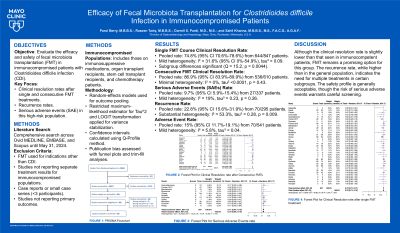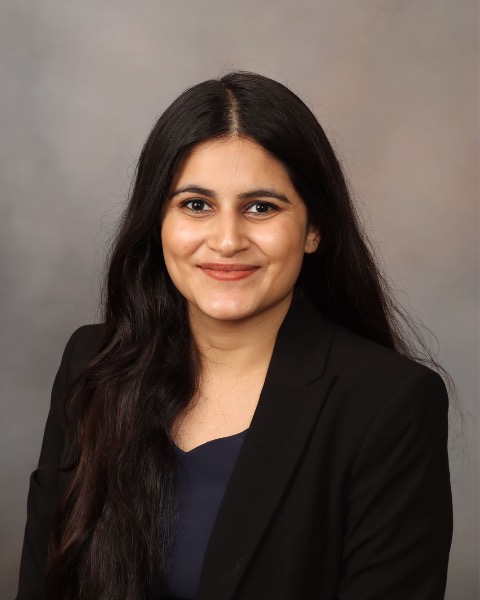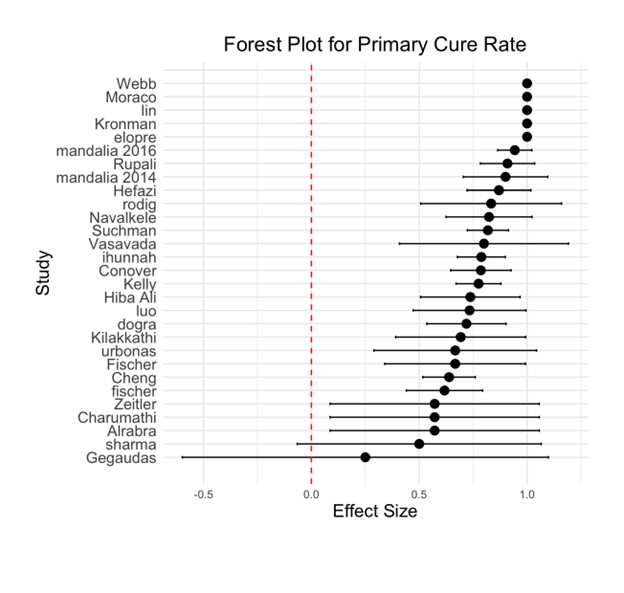Monday Poster Session
Category: Colon
P1943 - Efficacy of Fecal Microbiota Transplantation for Clostridioides difficile Infection in Immunocompromised Patients
Monday, October 28, 2024
10:30 AM - 4:00 PM ET
Location: Exhibit Hall E

Has Audio

Parul Berry, MBBS
Mayo Clinic
Rochester, MN
Presenting Author(s)
Parul Berry, MBBS, Raseen Tariq, MBBS, Darrell S. Pardi, MD, MS, Sahil Khanna, MBBS, MS
Mayo Clinic, Rochester, MN
Introduction: Clostridioides difficile infection (CDI) poses a significant health risk to immunocompromised hosts due to their heightened vulnerability and limited treatment options. Microbiota-based therapies have emerged as a promising strategy for CDI, but safety and efficacy in immunocompromised populations remain underexplored.
Methods: A comprehensive literature search across PubMed, Embase, and Cochrane Library from inception until May 2024 identified studies meeting inclusion criteria of FMT for CDI in immunocompromised individuals, including those on immunosuppression, transplant recipients, undergoing chemotherapy, and HIV. Studies of patients with inflammatory bowel disease not on immunosuppression and not separately reporting outcomes in immunocompromised patients were excluded. Case reports were excluded. Statistical analysis was performed using random-effects models to account for heterogeneity among studies.
Results: We included 34 studies comprising 9 case series and 25 cohort studies, including 767 immunocompromised patients. The pooled primary clinical cure rate of FMT for CDI among immunocompromised individuals was 84.03% (95% CI: 78.6%-89.4%) based on data from 30 studies involving 665 patients. The clinical cure rate after multiple FMTs was 88% (95% CI: 85%-91%).
Variability in efficacy across different subgroups of immunocompromised patients, including transplant recipients, individuals on immunosuppressive therapy, those with malignancy, and mixed cohorts was seen (p= 0.0024). Notably, the effectiveness estimate was lowest for patients undergoing transplant 64.3% (95% CI: [55.1%; 73.5%]), while subgroup analysis of studies reporting cancer patients showed highest efficacy 84.4% (95% CI: [75.2%; 93.7%]). Subgroups of mixed cohorts exhibited higher heterogeneity than others.
Discussion: Microbiota restoration with FMT appears to be an effective treatment option for CDI in immunocompromised hosts, with high clinical cure rates. Our sub-group analysis highlights the need to adopt tailored approaches for CDI among different categories of immunocompromised patients to maximize the benefits of FMT.

Disclosures:
Parul Berry, MBBS, Raseen Tariq, MBBS, Darrell S. Pardi, MD, MS, Sahil Khanna, MBBS, MS. P1943 - Efficacy of Fecal Microbiota Transplantation for <i>Clostridioides difficile</i> Infection in Immunocompromised Patients, ACG 2024 Annual Scientific Meeting Abstracts. Philadelphia, PA: American College of Gastroenterology.
Mayo Clinic, Rochester, MN
Introduction: Clostridioides difficile infection (CDI) poses a significant health risk to immunocompromised hosts due to their heightened vulnerability and limited treatment options. Microbiota-based therapies have emerged as a promising strategy for CDI, but safety and efficacy in immunocompromised populations remain underexplored.
Methods: A comprehensive literature search across PubMed, Embase, and Cochrane Library from inception until May 2024 identified studies meeting inclusion criteria of FMT for CDI in immunocompromised individuals, including those on immunosuppression, transplant recipients, undergoing chemotherapy, and HIV. Studies of patients with inflammatory bowel disease not on immunosuppression and not separately reporting outcomes in immunocompromised patients were excluded. Case reports were excluded. Statistical analysis was performed using random-effects models to account for heterogeneity among studies.
Results: We included 34 studies comprising 9 case series and 25 cohort studies, including 767 immunocompromised patients. The pooled primary clinical cure rate of FMT for CDI among immunocompromised individuals was 84.03% (95% CI: 78.6%-89.4%) based on data from 30 studies involving 665 patients. The clinical cure rate after multiple FMTs was 88% (95% CI: 85%-91%).
Variability in efficacy across different subgroups of immunocompromised patients, including transplant recipients, individuals on immunosuppressive therapy, those with malignancy, and mixed cohorts was seen (p= 0.0024). Notably, the effectiveness estimate was lowest for patients undergoing transplant 64.3% (95% CI: [55.1%; 73.5%]), while subgroup analysis of studies reporting cancer patients showed highest efficacy 84.4% (95% CI: [75.2%; 93.7%]). Subgroups of mixed cohorts exhibited higher heterogeneity than others.
Discussion: Microbiota restoration with FMT appears to be an effective treatment option for CDI in immunocompromised hosts, with high clinical cure rates. Our sub-group analysis highlights the need to adopt tailored approaches for CDI among different categories of immunocompromised patients to maximize the benefits of FMT.

Figure: Forest plot for Primary Cure Rate (N=30 studies; studies not reporting primary cure or studies with single participant excluded; p-value = 0.0001)
Disclosures:
Parul Berry indicated no relevant financial relationships.
Raseen Tariq indicated no relevant financial relationships.
Darrell Pardi: AbbVie – Consultant. Applied molecular transport – Grant/Research Support. Finch – Grant/Research Support. Immunic – Consultant. Otsuka – Consultant. Pfizer – Grant/Research Support. Phantom Pharmaceuticals – Consultant. Seres – Consultant, Grant/Research Support. Takeda – Grant/Research Support. Vedanta – Consultant, Grant/Research Support.
Sahil Khanna: Ferring Pharmaceuticals, Inc. – Grant/Research Support. Finch – Grant/Research Support. Pfizer – Grant/Research Support. Probio Tech, LLC – Consultant. Rise – Consultant. Seres Therapeutics – Grant/Research Support. Takeda – Consultant. Vedanta – Grant/Research Support.
Parul Berry, MBBS, Raseen Tariq, MBBS, Darrell S. Pardi, MD, MS, Sahil Khanna, MBBS, MS. P1943 - Efficacy of Fecal Microbiota Transplantation for <i>Clostridioides difficile</i> Infection in Immunocompromised Patients, ACG 2024 Annual Scientific Meeting Abstracts. Philadelphia, PA: American College of Gastroenterology.
